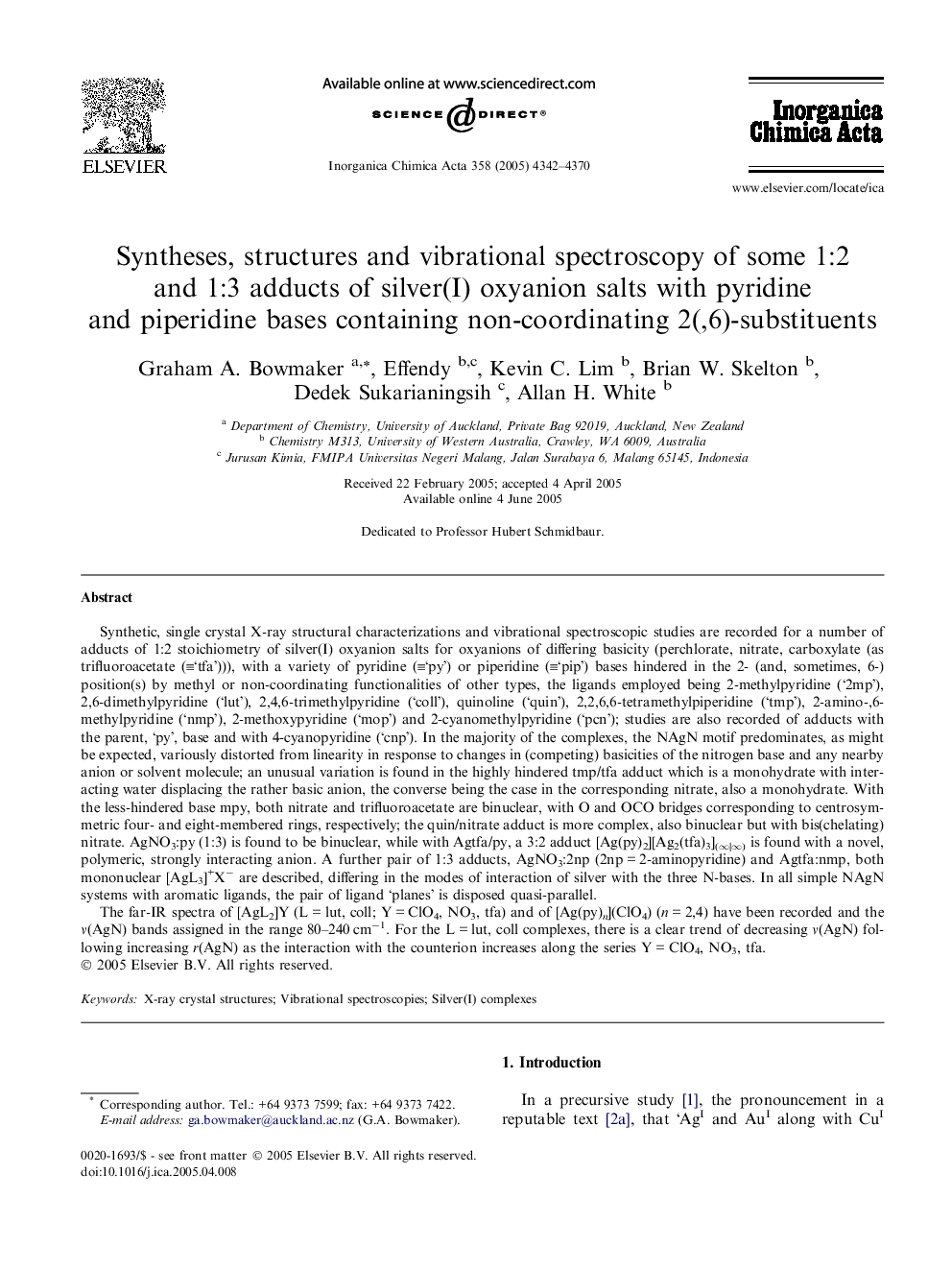| کد مقاله | کد نشریه | سال انتشار | مقاله انگلیسی | نسخه تمام متن |
|---|---|---|---|---|
| 1308408 | 975172 | 2005 | 29 صفحه PDF | دانلود رایگان |

Synthetic, single crystal X-ray structural characterizations and vibrational spectroscopic studies are recorded for a number of adducts of 1:2 stoichiometry of silver(I) oxyanion salts for oxyanions of differing basicity (perchlorate, nitrate, carboxylate (as trifluoroacetate (≡‘tfa’))), with a variety of pyridine (≡‘py’) or piperidine (≡‘pip’) bases hindered in the 2- (and, sometimes, 6-) position(s) by methyl or non-coordinating functionalities of other types, the ligands employed being 2-methylpyridine (‘2mp’), 2,6-dimethylpyridine (‘lut’), 2,4,6-trimethylpyridine (‘coll’), quinoline (‘quin’), 2,2,6,6-tetramethylpiperidine (‘tmp’), 2-amino-,6-methylpyridine (‘nmp’), 2-methoxypyridine (‘mop’) and 2-cyanomethylpyridine (‘pcn’); studies are also recorded of adducts with the parent, ‘py’, base and with 4-cyanopyridine (‘cnp’). In the majority of the complexes, the NAgN motif predominates, as might be expected, variously distorted from linearity in response to changes in (competing) basicities of the nitrogen base and any nearby anion or solvent molecule; an unusual variation is found in the highly hindered tmp/tfa adduct which is a monohydrate with interacting water displacing the rather basic anion, the converse being the case in the corresponding nitrate, also a monohydrate. With the less-hindered base mpy, both nitrate and trifluoroacetate are binuclear, with O and OCO bridges corresponding to centrosymmetric four- and eight-membered rings, respectively; the quin/nitrate adduct is more complex, also binuclear but with bis(chelating) nitrate. AgNO3:py (1:3) is found to be binuclear, while with Agtfa/py, a 3:2 adduct [Ag(py)2][Ag2(tfa)3](∞|∞) is found with a novel, polymeric, strongly interacting anion. A further pair of 1:3 adducts, AgNO3:2np (2np = 2-aminopyridine) and Agtfa:nmp, both mononuclear [AgL3]+X− are described, differing in the modes of interaction of silver with the three N-bases. In all simple NAgN systems with aromatic ligands, the pair of ligand ‘planes’ is disposed quasi-parallel.The far-IR spectra of [AgL2]Y (L = lut, coll; Y = ClO4, NO3, tfa) and of [Ag(py)n](ClO4) (n = 2,4) have been recorded and the ν(AgN) bands assigned in the range 80–240 cm−1. For the L = lut, coll complexes, there is a clear trend of decreasing ν(AgN) following increasing r(AgN) as the interaction with the counterion increases along the series Y = ClO4, NO3, tfa.
The N–Ag–N motif predominates in the title compounds of 1:2 stoichiometry, with distortions from linearity and a tendency to associate to form higher nuclearity clusters that are dependent upon the nature of the nitrogen base and the oxyanion. The 1:3 compounds include two new mononuclear silver(I) complexes in which silver is coordinated by three pyridine-base ligands.Figure optionsDownload as PowerPoint slide
Journal: Inorganica Chimica Acta - Volume 358, Issue 14, 15 November 2005, Pages 4342–4370